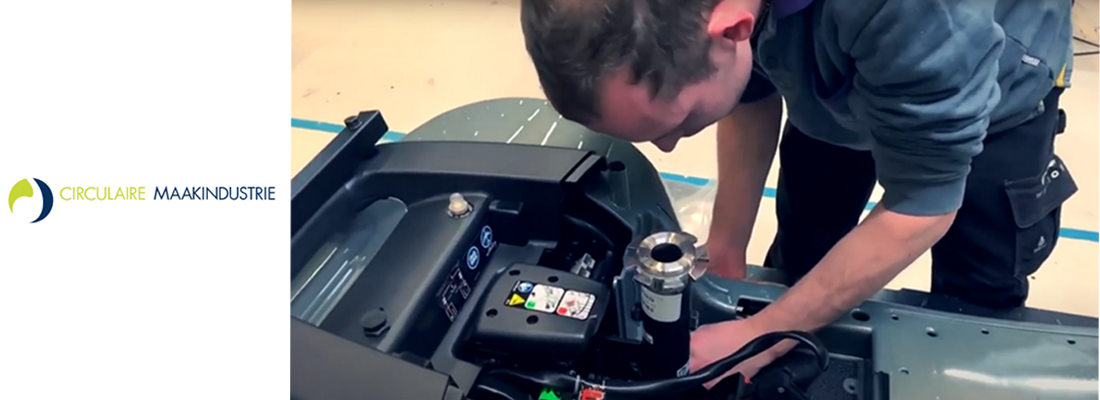Remanufacturing is a circular strategy with a lot of potential and is becoming increasingly popular: producers achieve higher margins or save costs, customers get the same quality for a better price and companies serve their customers better. But many of these opportunities are not yet being exploited and that is a shame, for producers and customers. In a series of 3 articles from the Dutch organisation Circulaire Maakindustrie, helping Dutch entrepreneurs with starting circulair processes within their organisation, they talk to different parties who successfully apply remanufacturing.
In this first article they speak to Bas Hillerström, freelance trainer and sector coordinator Manufacturing for CIRCO. Previously, he was interim project leader at Welzorg, a Dutch specialist in the field of care aids, and directed the "Welzorg Circular" project. He initiated parts remanufacturing there and, in combination with other circular strategies such as reuse, saved around 4 million euros in two years.
"Remanufacturing has to fight against the idea that new is always better."
What is remanufacturing?
Bas: “Many different definitions are being used for remanufacturing and refurbishment. They are also often used interchangeably.
What I find a nice description for remanufacturing is "to return a used product to at least its initial performance with warranty conditions that are the same or better than those for a new product". So it is about repairing, overhauling, upgrading used parts and systems. Many remanufactured products are even better than their original versions!
The difference with refurbishment can be found in the name. Refurbishment is also about repairing products and parts, however refurbishment is often placed under remanufacturing from a quality perspective. A mnemonic is that with remanufacturing, "manufacturer" is in the word. That means that you deliver factory or OEM quality. This is not the case with refurbishment. ”
"Many remanufactured products are even better than their original versions!"
How do you sell remanufacturing in your own organisation?
Bas: “I was at Welzorg for another project and then I made an appointment with the director on my own initiative. Welzorg had been at a loss for a while and had to cut back. I calculated how much circular working could yield them. I promised to save a million within a year. We certainly succeeded, we saved about four million in two years.
In this context it is important to mention that Welzorg derives most of its turnover from rental and thus remains the owner of the mobility scooters. When it comes to sales, remanufacturing is also interesting, as the margins on the sale of remanufactured products are often higher for the producer than on new build products. Ultimately, this depends on the value of the product. In a general sense, the more expensive the product, the more interesting remanufacturing becomes.
We first looked at which products were frequently purchased. To this end, we dug into the stock systems to analyse the turnover rate and product value of spare parts. What emerged was that drive motors for mobility scooters were frequently purchased and cost 1,000 euros each. We have sent them to Remade in Holland with the question what it costs to remanufacture them. That turned out to be 300 euros each, with the same warranty as a new part. That is a saving of 70%.
This sometimes frustrates me, it is so obvious and the money is often literally there for the taking. Usually obsolete products or parts are quickly seen as waste and worthless. Waste management is usually seen as a “must” and therefore little or no optimisation is done. Due to this outdated view and lack of focus, remanufacturing is difficult to get off the ground. But, the potential is enormous! You just have to check: is it worth a lot, do I throw it away now, let me send it to a remanufacturing party to request a price. You save a lot with that.
In addition to money, we have saved 75% waste. First, four sea containers of mobility scooters a week went out the door and we reduced that to one. Based on these and other experiences, I still see a lot of untapped potential when it comes to remanufacturing. Mainly ecologically but also economically. ”
“If it's worth a lot and I'm throwing it away now, let me send it to a remanufacturing party to request a price. You save a lot with that."
How do you see the future for remanufacturing?
Bas: “With remanufacturing you get the most out of products that are currently on the market. It is a hugely undervalued chapter in the circular economy, while it offers enormous potential for existing companies. At the moment we still have the idea that new is better, but I see that changing. There is a whole generation that knows that something has to change. If labour also becomes cheaper and materials more expensive, things will go fast. ”
Tips
- • Use the correct message. Saving money was a first step for Welzorg. The reason for a different company can be different, such as opening up a new customer group, reducing environmental benefits or reducing dependence on suppliers.
-
• If you are viewing it from a company then someone must give approval to get started. Bas asked the director for permission to start the project. Then a team was set up with people needed to achieve the results. Think of purchasing manager, workshop manager and logistics manager.
- • Remanufacturing is an enormously undervalued chapter in the circular economy, while it is desperately needed to get the most out of products that are now on the market. And companies are losing a lot of money through it. So get started today.
Read the full Dutch article here: https://circulairemaakindustrie.nl/nieuws/hoe-verkoop-je-remanufacturing-1/






